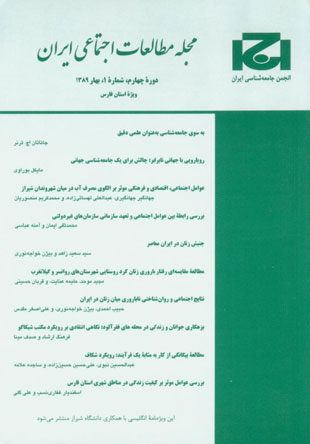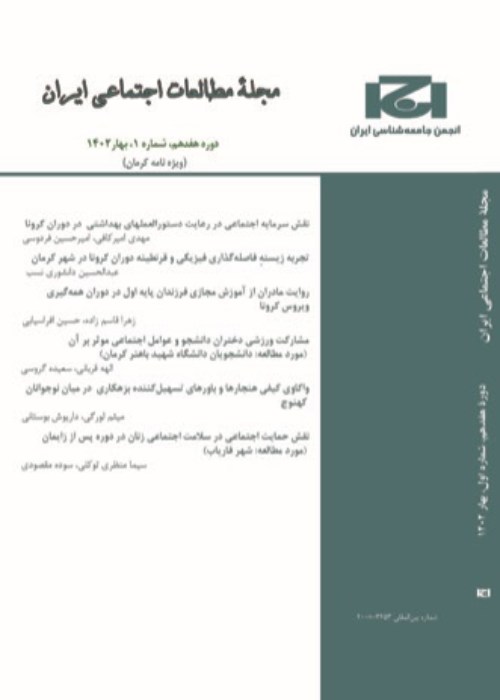فهرست مطالب

مجله مطالعات اجتماعی ایران
سال چهارم شماره 1 (پیاپی 9، بهار 1389)
- 218 صفحه، بهای روی جلد: 15,000ريال
- تاریخ انتشار: 1389/02/11
- تعداد عناوین: 11
-
-
صفحه 3
-
بررسی رابطه بین عوامل اجتماعی و تعهد سازمانی سازمان های غیر دولتی / مورد مطالعه: سازمان های غیر دولتی زنان شهر شیرازصفحه 69
-
صفحه 87
-
مطالعه بیگانگی از کار به مثابه یک فرآیند: رویکرد شکاف / مورد مطالعه: کارمندان سازمان های دولتی شهرستان اهوازصفحه 161
-
Page 3
-
Page 5Since sociology's inception as a discipline, basic tension between science and advocacy has always existed. This paper reviewed the arguments for and against scientific sociology with an eye to offering another way to reconcile valueneutral theory and research with what recent sociology now calls "sociological practice" or the application of sociological knowledge to real world settings. The paper has found that the only way to use theoretically informed knowledge is to reject ideology and, instead, become social engineers rather than advocates for some value-laden ideological position. It is not the goal of sociology to decide for other what is good or bad, rather, it is the goal of sociology to understand how the social world operates and, then, to make this knowledge available for those engaged in building and rebuilding sociocultural constructions.
-
Page 35The challenge of global sociology can be seen in defining its object, but just as important the challenge calls for recognition of the inequalities and dominations that divide the international community of sociologists. This was focus of the conference of National Sociological Associations that took place in Taipei in March, 2009. Here we discussed such inequalities as linguistic domination, economic divides, political oppressions, regional constellations within which these inequalities crystallize as well as emergent global disciplinary hierarchies promoted by a widespread audit culture. Only by first understanding these divisions can we begin to develop a global community that willtranscendnational boundaries, but also defend the interests of sociologists within local, national and regional contexts, and, on that basis, tackle the enormous problems generated by the new era of globalization.
-
Page 49This article mainly aims at measuring the impact of social, cultural and economic variables on the amount of drinkable-water consumption in Shiraz based on "Bourdieu" theory. This theory has been used due to its emphasis on the three-fold variables and their relations to consumption and taste. In this survey study, family income, architectural characteristics of the residence, household equipment, employment status of the respondent, family size, place of residence, place of birth, work position of the respondent, work position ofthe head of the family, age of the respondent, educational status of the head of the family, time spent out of home, respondent's awareness and special habits were used as independent variables. As a part of the study, for gathering the data by completing the questionnaire,900 household's wives were selected based on the "Lin" sampling formula. The data were analyzed by using the analysis of variance,bi and multi-variate regressions. The results showed that family income, type and architectural characteristics of the residence, hydroactive equipment, employment status of the respondent, family size,respondent's job position, the time s/he spends out of home, their awareness and special habits were the variables that have a significant relation with the annual water consumption of the families.ln the final analysis, using a multi-variate regression -with step-wise method- it was shown that five variables - amely,family size, residence area, special habits, family income, and the size of the house yard- were entered in the equation and could explain 30% of changes in the water consumption.
-
Page 69The aim of this article is to examine the relationship between social factors and organizational commitment of Shiraz's women's NGOs. In this study, survey method is used and data were collected through structured questionnaire from 205 members who were selected randomly. According to the research findings, there are significant relationships between affective organizational commitment and participation, organizational support, organizational capital, organizational expectation, socialization and satisfaction. Also there are significant relationships between normative organizational commitment and participation, organizational support, organizational capital, organizational expectation and satisfaction. Regression results show that organizational support has explained 19 percent of the variation of affective commitment. Also organizationalsupport has explained 25 percent of the variation of normative commitment. In path analysis model, the five above' independent variables have directly significant effect on dependent variables.
-
Page 87Women's movement in Iran started in late nineteenth and early twentieth centuries under the influence of modernism imported from Europe. This movement has two main trends in Qajar and Pahlavi periods: (a) western oriented and (b) Islamic stream. During Qajar rule both trends were not well formed. They acted under the influence of main socio-political social movement flows of the society. In Pahlavi era western oriented movement was promoted by the state and the Islamic stream marginalized. In the first and second decades of Islamic Republic time the Islamists were baked by the government. In the third decade of the revolutionary government, open atmosphere of the society causes four groups to be recognized: (a) a western oriented group, (b) amodernized Islamic group, (c) a traditional Islamic group, and 9d) a progressive Islamist group. This paper will review the historical path of the movement in brief and will introduce the four competing trends of the day.
-
Page 111The purpose of this study is to investigate fertility differences, among the people of villages of Ravansarand Gilangharb whose religions are Sunnite and Shiite respectively. The study aims at answering the question as whether religion as a cultural variable can cause fertility differences in an ethnic group with two different religions. In the survey 550 married women aged 15-49 were selected as the sample (including 220 Sunnites and 330 Shiites). The theoretical framework of the study is religion and fertility theory embracing characteristics, particularized theology and minority group status hypotheses. The study utilizes a combination of characteristics and minority group status hypotheses. Thefindings of the study show that women religions do not have a significant correlation with fertility behavior. It was found that often hypotheses related to Sunni women, except abortion experience, other variables have a significant correlation with fertility behavior. The relationships between all variables are significant in Shiite women. Also, the results of the study show that the most important factors influencing fertility behavior are marriage duration, experiencing child loosing, age of first fertility and husband's education. Thesevariables explained %74 of fertility behavior variance. Unexpectedly, the religion was not the main factor leading to fertility differences.
-
Page 125The goal of this article is to study the social and psychological consequences of infertility among women, to determine the tension sources and the consequences of infertility among women, awareness of the couples about this problem, determining the psychological and social factors, determining competing strategies for the compatibility of the infertile women and their husbands with regards to this problem. The conceptual framework of the research will be designed with the use of social and psychological theories.A self-report questionnaire, applied in the survey form, was used to collect therequired data. The self-reported data was obtained through questionnaire from a sample of about 400 of the couples Fars and Yazd province (twoprovinces of Iran), who have referred to infertility centers in these provinces. One-way analysis of variance and matrix correlationwere the statistical techniques used in the data analysis. The findings show education of couples, cooperation among couples and the tolerance of difficulties help adaptation to this difficulty and solving the problems.
-
Page 147This paper is resultedfrom a fieldwork research doing in Ahwaz City of Iran. The sample group of this study, consisting of 200 juvenile delinquents, is randomly selected from a population arrested between 1996 - 2001.As the majority of them belong to the lower class urban residents, they are mainly from the families living in the poor slum areas of Ahwaz. Assuming that the salient feature of slums to be the inadequate housing conditions (IRq, this research is conducted to study the relationship between the different levels of IRe and the relative intensity of delinquency. With a critical view on the Chicago School approach, it is maintained that the mere ecological elements, or even theshortcoming of social control, could not to be the independent factors making the "favourable place for commitment of crime and delinquency", but poverty, job instability, and lack of educational achievement, or depression as a whole, could be the determinant factors for delinquency commitment.
-
Page 161This paperaims at studying alienation within work context as a specific social system and correlations between the dimensions of alienation by applying the discrepancy approach, using some aspects of Seeman, Blauner and Faunce's theories. Powerlessness, meaninglessness andnormlessness are takenas independent variables and self-estrangement as dependent variable andas an indicator of work alienation. This researchis conducted on the survey method. A multi level random sampling method has been used for selection of the samples; Main instrument of data collection used in this study was questionnaire.TheSample of the research includes 400 members drawn from employees in governmental organizations in Ahwaz, capital of Khuzestan, aprovince in south west of Iran, in the year 2009.Findingsshow significant and positive relationsbetween powerlessness, meaninglessness and normlessness with selfestrangement (work alienation). The results of multiple regression showthatnormlessness and powerlessness have the most effect on selfestrangement.Also, the results indicate that there are significant relations between age, education and organizational positions with dimensions of alienation, buttheseindividual characteristics do not affect relationship between percieved powerlessness, meaninglessness and normlessness with selfestrangement (work alienation).
-
Page 183Studies related to the quality of life and investigating it in human societies have been of great importance in recent days as an axis of government efficiency. Such studies have always tried to be increased in human residences by investigating factors affecting the improvement of quality of life both in objective (availability of material facilities), and subjective aspects (satisfaction). This research has used a correlation analysis based on the results of a 20-percent count of statistics by the Iranian Statics Center in 1385 (2006) to investigate objective aspects of the quality of life and factors affecting it inurban areas of Fars province. Indicatorsused in this research include availability of facilities to families and their housing quality. The results show a direct relationship between population size of the residence and the facilities available to the family as well as their quality. The higher the education of family guardian-- is which results in a better job opportunity -- the better facilities available to the family and the higher their quality will be. On the other hand, in small cities (those with a population below 50,000) better quality housesare available due to lower prices, yetit does not affectavailable facilities family.


